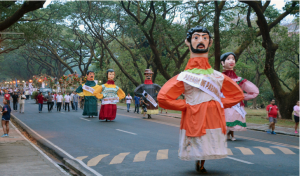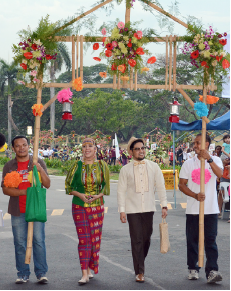By Anna E. Regidor, images by Leonardo A. Reyes, Jefferson Villacruz
UP Diliman (UPD) flaunted its best and brightest in a parade greeted with cheers and fanfare as students, faculty and staff achievers marched around the Academic Oval for the first ever Parada ng Parangal (Parade of Honor) on May 4.
Drawing inspiration from the colorful sagala, a pageant held in many towns and cities in the Philippines in May, the Parada featured one or more pairs from the University’s 27 degree-granting units, each representing the significant achievements of their college in the past year.

Student achievers proudly represented their home units. Among them were summa cum laude Emir-Deogene Mendoza of the National College of Public Administration and Governance, Aileen Bacalso of the Asian Center, the first individual awardee of the prestigious Emilio Mignone International Human Rights Prize from the Argentine Ministry of Foreign Affairs, and Louise Seiko V. Hashimoto, University Athletic Association of the Philippines (UAAP) student athlete of the year from the College of Human Kinetics.
Among the faculty were Prof. Alonzo A. Gabriel, one of the 2014 Ten Outstanding Young Persons of the World; Dr. Windell L. Rivera, director of the Natural Sciences Research Institute and professors Yna Santos and Mark Santos from the School of Library and Information Studies. Hardworking members of the administrative staff were represented by Aloha Nacu, Student Record Evaluator and driver Ricardo Moralejo from the College of Engineering.

In addition to the pairs, each college contingent included carriers of flower-decked arches, the college banner and flag. Some colleges also had torch bearers illuminating the evening walk and a music band. The parade began at 5:15 p.m., led by members of the UPD Reserve Officers Training Corps and Acting Chief Security Officer Atty. John S. Baroña. The cadets were followed by six Higantes from Angono, Rizal, giant human-shaped paper-mache figures, each wearing a sash with the major events of the Linggo ng Parangal: the Parada ng Parangal, the Chancellor’s International Reception (May 4), the Parangal sa mga Magaaral (May 6), the Parangal sa mga Retirado at Gawad Paglilingkod (May 7) and the Gawad Tsanselor (May 8).
Higantes are the main attraction of an annual festival held each November in honor of the town’s patron saint, Saint Clement.
The Higantes were followed by Assistant Vice President for Public Affairs Jose Wendell P. Capili. With him were parade Hermanos UPD Chancellor Michael L. Tan, Vice Chancellor for Academic Affairs Benito M. Pacheco, Vice Chancellor for Student Affairs Neil Martial R. Santillan and Vice Chancellor for Community Affairs Nestor T. Castro. The centerpiece of the parade was a float which seated the 2015 Gawad Tsanselor awardees, followed by the Royal Knights Drum and Lyre Corps from Barangay Krus na Ligas. The float was tailed by the cadre of flag girls and a marching band that was warmly welcomed by the crowd.
A short program followed the parade, where the unit representatives were each called on stage and introduced to the audience. The program also featured performances from the UP Filipiniana Dance Group, a solo by Marynor Madamesila from
the College of Arts and Letters and the UP Rondalla.
The Parada formally opened Linggo ng Parangal, the University’s weeklong celebration of the excellence, accomplishments and dedicated service of its faculty, researchers, students, administrative staff and community. Castro said the Parada is also meant to add color to the Linggo ng Parangal celebrations and has roots in three summer traditions, namely the Boy Scouts Parade that traditionally opens the Linggo ng Parangal, the Flores de Mayo celebration usually held during May and the Cadena de Amor.
The Cadena de Amor is a UP tradition started in 1934 where the responsibilities of senior co-eds were symbolically turned over to the Juniors through the passing of long garlands of cadena de amor, the flower of a climbing vine native to Mexico and found throughout the Philippines. It was usually held in May until the practice was discontinued in 1969.
